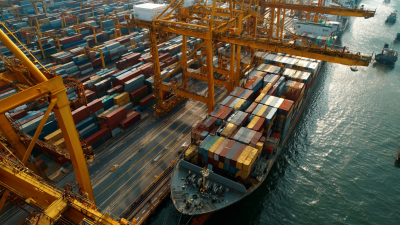 The logistics landscape in China has undergone significant transformation over recent years, particularly in the realm of courier services. As a vital component of the e-commerce ecosystem, the China Courier Service industry has evolved to meet the increasing demand for faster, more reliable delivery solutions. This evolution has been driven by various trends such as
technological advancements, shifts in consumer behavior, and the growing integration of automated systems.
However, alongside these opportunities, the sector faces challenges including regulatory hurdles, environmental concerns, and intense competition among service providers.
As we delve into the dynamics of China Courier Service, it becomes essential to explore not only the current trends shaping the industry but also the obstacles that must be navigated to ensure sustainable growth.
Understanding these aspects will provide valuable insights into the future prospects of China's courier services, making it a crucial area of study for stakeholders and policymakers alike.
The logistics landscape in China has undergone significant transformation over recent years, particularly in the realm of courier services. As a vital component of the e-commerce ecosystem, the China Courier Service industry has evolved to meet the increasing demand for faster, more reliable delivery solutions. This evolution has been driven by various trends such as
technological advancements, shifts in consumer behavior, and the growing integration of automated systems.
However, alongside these opportunities, the sector faces challenges including regulatory hurdles, environmental concerns, and intense competition among service providers.
As we delve into the dynamics of China Courier Service, it becomes essential to explore not only the current trends shaping the industry but also the obstacles that must be navigated to ensure sustainable growth.
Understanding these aspects will provide valuable insights into the future prospects of China's courier services, making it a crucial area of study for stakeholders and policymakers alike.
The rise of digital transformation in China's courier services has become a focal point in the wake of the COVID-19 pandemic. As the country grappled with the health crisis, traditional logistics models faced significant challenges due to restrictions on movement and a surge in online shopping. The pandemic accelerated the adoption of digital tools and platforms, enabling courier companies to enhance efficiency, streamline operations, and meet the heightened demand for delivery services.
This digital shift has not only allowed courier services to adapt to the new normal but has also positioned them for future growth. Innovations such as automated sorting systems, advanced tracking technologies, and data analytics are becoming commonplace, providing customers with real-time updates and improving service reliability. As consumer behavior continues to evolve, the integration of AI and machine learning into logistics operations is expected to further enhance operational efficiency and customer experience, paving the way for a more resilient and responsive courier industry in China.
The future of delivery logistics in China is being shaped by several key trends that reflect the rapid evolution of the industry. One of the most significant influences is the rise of autonomous logistics, which has been prioritized by Beijing as a critical component of its national agenda. By 2030, the initiative aims to deploy a fleet of ghost trucks to optimize the efficiency of freight movement while addressing labor shortages and reducing operational costs. This technological advancement is expected to revolutionize last-mile delivery and improve overall logistics performance across the nation.
Additionally, the surge in e-commerce has driven the demand for innovative solutions such as parcel lockers to streamline last-mile delivery. This method not only caters to the growing consumer preferences for convenience but also helps reduce congestion and environmental impact in urban areas. In tandem with these developments, the logistics technology landscape is evolving rapidly, with an emphasis on integrating global supply chains and utilizing data analytics to enhance operational strategies. As these trends continue to unfold, they will significantly influence the dynamics of the courier services sector in China, positioning it for a more efficient and sustainable future.
| Dimension | Data |
|---|---|
| Market Size (2023) | $90 Billion |
| Annual Growth Rate (CAGR 2020-2025) | 15% |
| E-commerce Contribution | 70% |
| Challenges Faced | High Competition, Regulatory Changes, Labor Shortages |
| Technology Adoption Rate | 85% |
| Sustainability Initiatives | 30% of Firms Implementing Green Practices |
| Future Outlook (Next 5 Years) | Expansion into Tier 3 and 4 Cities |
The courier industry in China is undergoing significant transformation as it navigates the challenges posed by the digital age. One major obstacle is the fierce competition among both established players and new entrants, which drives down prices and affects service quality. With the rise of e-commerce, customer expectations have intensified, demanding faster deliveries and enhanced tracking systems. This rapid increase in demand strains existing logistics networks, compelling companies to innovate in order to stay competitive.
Tips: To thrive in this environment, courier companies should invest in technology to streamline their operations. Implementing AI-driven logistics platforms can optimize delivery routes and improve efficiency. Additionally, fostering partnerships with local businesses can strengthen supply chain networks and enhance service reliability.
Furthermore, regulatory hurdles also present a challenge. The evolution of laws regarding data privacy and customer rights requires couriers to adapt quickly or face penalties. Ensuring compliance while also maintaining agility in operations is critical for success.
Tips: Engaging in proactive dialogue with regulators can help courier services stay ahead of potential challenges. Training employees on compliance measures will not only mitigate risks but also enhance trust with customers, solidifying the company's reputation in a highly competitive market.
The courier services in China are undergoing a significant transformation, driven by innovative technologies that are reshaping the logistics landscape. Robotics, artificial intelligence, and smart city initiatives are at the forefront of this revolution. For instance, Shenzhen has recently trialed autonomous robots for freight delivery within its metro system, which not only enhances operational efficiency but also alleviates urban congestion. Such advancements signify a trend towards automation in logistics, promising faster and more reliable delivery services.
Tips: To optimize your automated delivery processes, consider integrating AI-driven logistics management systems that can predict demand and optimize routing. Additionally, investing in smart technologies will streamline operations and enhance customer satisfaction.
Moreover, the first and last mile delivery markets are anticipated to grow substantially from $186.6 billion in 2025 to approximately $446.4 billion by 2034. This growth is fueled by the rising demand for efficient delivery solutions in e-commerce, and the incorporation of cutting-edge technologies such as drones and delivery robots. Embracing these technologies enables courier services to meet the increasing expectations of consumers for speed and reliability.
Tips: Regularly assess emerging technology trends and invest in the latest tools that can improve delivery accuracy and reduce operational costs. Establishing partnerships with tech innovators can also provide valuable insights into effective execution strategies.

As the courier industry in China evolves, the emphasis on sustainability and efficiency in delivery operations becomes increasingly critical. With the global digital freight brokerage market projected to grow from $7.69 billion in 2025 to an impressive $74.86 billion by 2033, logistics companies can no longer overlook sustainable practices (Market Research Reports). The integration of advanced technologies and eco-friendly strategies not only helps in reducing carbon footprints but also enhances operational efficiencies.
Tips: Embrace technology-driven solutions such as AI to optimize delivery routes and predict demand accurately. Streamlining warehouse logistics through high-standard facilities can significantly improve turnaround times and inventory management.
Furthermore, as per Deloitte’s 2025 Global Retail Power report, the focus on operational efficiency and sustainability remains paramount, alongside the integration of innovative technologies like AI. Companies that pivot towards these trends are better positioned to tackle the challenges posed by fluctuating consumer demands and supply chain disruptions.
Tips: Regularly assess your delivery operations and adopt sustainable packaging solutions. Utilizing data analytics can provide insights into improving service delivery and reducing waste throughout the logistics chain.








